Northern Flicker
Colaptes auratus
Status: Secure
The Northern Flicker is a woodpecker found all throughout North America. There are two different types of flicker, yellow-shafted and red-shafted. The yellow-shafted flickers are mostly found in the east and north parts of North America and the red-shafted flickers are mostly found in the western parts. Yellow-shafted flickers have yellow tails and yellow underwings with a gray head and nape. The male yellow-shafted flickers have black whiskers. The red-shafted flickers have red tails and red underwings, they also have a brown head with a gray face. These males have red whiskers instead of black ones.


Habitat & Range
The northern flickers are found all over North America, throughout Canada and the United States. These flickers are able to live in a wide range of habitats as long as there are trees. They tend to stay away from forests that are too dense because they need open ground for foraging (searching for food).
Food Web & Energy Flow
The main diet of Northern flickers consists of seeds and insects. Some of the insects they eat include ants, caterpillars, stink bugs, grasshoppers, and beetles. During the winter seasons, the sparrows rely mostly on seeds and berries. With this diet, these flickers are considered secondary consumers.
Relationship to Fire
Northern flickers consume most of the insects and seeds found on the forest floor. After a controlled fire happens, seeds and other material may fall to the ground leaving more food for the birds to eat. Without these frequent fires, it may become harder for the birds to find food, which may cause the birds to roam further away from their nesting sites. This can expose them to more predation the longer they take finding food.

Conservation Status
Although the northern flickers are considered Secure, they are dealing with habitat destruction and land use in many regions in North America. Human impact is slowly causing a decline in their overall population.

Human Impacts/ Threats

Fire Suppression
Many people think of fires in the forest as bad, so they work hard to prevent or suppress them. But longleaf forests NEED regular fire to support habitat for the species that live there!

Land Use Conversion
Longleaf forests and the habitat it supports is being cleared or converted to use the land for other uses like houses, roads, agriculture, and even to grow different types of trees to sell.
Resources
Audubon. Guide to North American Birds
USGS. Migratory Bird Research
Missouri Department of Conservation. Field Guide
